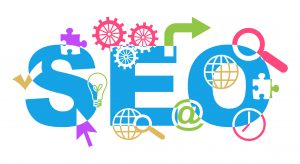Digital marketing for B2B project
Often you have to communicate with the owners of companies to which the main sales are brought by corporate clients. These are manufacturers, official regional dealers, services, B2B portals. All of them are united by the same shortcomings in digital marketing and self-promotion. I decided to show how professionals without global investments increase the efficiency of salespeople, expand the customer base and build relationships with partners from a position of strength and mutual benefit at the same time.

This is a series of seven articles, which contains only practical and working schemes:
- SEO for B2B.
- Sales and digital marketing.
- Dealer shop.
- SMM and contextual advertising for B2B.
- Email and content marketing in B2B.
- Partners are interested in cool marketing.
- Monetization through B2C.
- Today we will look at the first three articles.
1. SEO for B2B
It so happened that clients, thinking about digital marketing, are primarily looking for this source of lead generation.
How to Know What SEO Needs
SEO is necessary for everyone who has at least three competitors in a group of goods or services. The more important question is how long it will take for the investment to pay off.
Study your competitors. If they sell on the site, then SEO can work in a plus.
Contact any SEO specialist to estimate how much potential traffic your topic has (usually a free service).
The minimum that everyone needs:
- SERM (search engine reputation);
- information directions (brand descriptions, vacancies, instructions and official product characteristics);
- elaboration of the SEO-usability of the project structure;
- search for related directions for different segments of the target audience (for organic traffic).
How to check if SEO is paying off
There are three methods:
1. Simulation modeling. Buy traffic from the context and evaluate whether these requests bring customers. Organic traffic is 2-10 times cheaper than contextual traffic (and at the same time larger in volume).
2. Analytical modeling. Here you can’t do without a senior SEO specialist: you need to count the investments of competitors, build the project structure and the expected volume of traffic, calculate the basic conversion, and set usability coefficients. It is easier to hold a tender, look at contractors’ KPIs and assess whether you can afford the investment for such results.
But everything is not so simple. Contractors often make deliberately inflated forecasts (sometimes unconsciously) because the project evaluation is not carried out by a senior specialist. You believe in numbers that are not based on anything. In this case, you should contact an SEO expert (who is not interested in promoting your project, he usually has a higher minimum check than yours) to check the correctness of commercial offers.
3. Benchmarking. Look for insider information from competitors about how much money SEO brings in and what investments are made into it. Every second client comes to our studio with such a “confirmation” of payback.
What is being implemented on most B2B SEO projects
1. Pages are created for promoted high-frequency queries (products, sections, services, manufacturers and suppliers: “dresses wholesale”, “accountant Kyiv”, “pipe manufacturer” and so on).
This is done even by a novice SEO specialist on a project. But these are the most competitive requests in the niche, and therefore require more time, investment and high optimizer skills.
2. The structure is expanding due to pages of filters, taxonomies, synonyms (“wholesale red dresses”, “chief accountant”, “pipe plant”).
Usually these pages are poorly developed: for some reason, B2B projects think that they are searched for only by high-frequency queries, but, as you can see, there are such queries in the search results.

With the right approach, you will get a large source of B2C traffic (for example, a “red dress”) without much investment, and this is both a trust for the project as a whole and the ability to monetize it.
3. Related non-obvious requests are generated with possible conversions (“wholesale knitwear”, “resume accountant”, “gost pipe” and so on).
This is rarely used: to dig up “precious” requests, you need to think. But they are always there. This is exactly the option when 2% of traffic gives 15% of sales from SEO and context.
4. Content is produced (for each business its own – from articles to videos with guidance).
It is difficult to overestimate the importance of this item if you know how to use it. Some of the materials go to your B2B buyers in the future (so that your products are bought in their online stores).
5. Landing traffic pages are organized that can generate conversions primarily for the context (supplier descriptions, portal content output format, discussion reviews, and so on).
These are difficult points of contact with the site for a quality target audience. They are quite individual for each project, but they provide excellent traffic with some of the highest conversions (especially when properly boosted with remarketing).
6. Affiliate sites are being developed (sometimes on subdomains) for regions (new countries), languages and winning the top 2-10 positions by one business.
If you are already in first place or, conversely, just starting, it makes sense to take several positions in the top 10 at once or look for “g
blue ocean. And you can do it right away. The main thing is to correctly assess the potential and opportunities. The item is individual, requires understanding of the project.
7. Related projects are launched, most often informational – for example, a fashion portal for a top fashion dress dealer.
Information traffic to the site itself affects the issue of branding.
8. Technical work is underway – from assessor design to the implementation of all the recommendations of search engines on the site.
Typically, B2B projects are poorly developed in terms of user convenience and trust. This is an SEO problem that yields great results when solved. On the other hand, internal optimization in top niches is not far behind B2C sites. Most projects no one tries to optimize.
9. Create official threads on forums where it makes sense. This is necessary for direct communication with customers in an environment where they feel protected.
This is both traffic and SEO trust. Not relevant for all B2B niches.
10. SEO PR campaigns.
This is also not suitable for everyone. If your product is widely discussed and your target audience is active online, then the results are noticeable.
11. Studying partners for the presence of links to the project (sometimes with the offer of additional monetization for traffic from their site).
I will tell you more about this in the second article. But links from partners are the best for SEO promotion today, you can ask any smart optimizer about this.
I will note a few points from marketing that affect SEO and are often implemented:
Contextual advertising. It is important for B2B for high-converting non-obvious requests. It costs a penny, but gives the best audience: “kindergarten toys”, “doors for hotels”, “[product] wholesale [direct competitor]” and so on. Then it generates direct traffic – and this, in turn, is one of the key factors in promoting B2B.
Media advertising. Use remarketing and display networks for high-converting queries. Branding for B2B is of particular value: on the one hand, the target audience is small, but spends a lot all the time, on the other hand, direct traffic has a good effect on SEO indicators. This is one of the reasons why “non-optimized” sites are at the top.
Reverse SEO factors that affect other areas of digital marketing:
- Gathering the best competitor content by social virality, organic traffic and backlinks. This usually leads to a professional content marketing start.
- Real-time SEO monitoring of the state of competitors allows you to quickly learn about the expansion of projects. This generates good solutions (new assortment, franchising, the right tools) immediately, and not in a year.
- Regional SEO traffic is often a great platform to launch a franchise (or at least expand into new markets). So, the request for “wholesale dresses in Chernihiv” is almost zero, but “dresses in Chernihiv” is affordable – but in order to sell them, you will need partners. This will be in the dealer section.
- Control of new links of competitors helps to get feedback from failed or unsuccessful clients, performance was checked for SEO. In the same way, we help our friends in search of “warm” contacts.
- AMP from Google, assessment design, SEO usability blocks are a must-have set for any project that generates, in addition to results in SERP, an increase in conversions.
- The right semantic core for SEO is a great base for contextual advertising. In addition, it helps to make a lot of business decisions (which section to promote, which markets to enter) and build marketing models without buying expensive research (transparent seasonality, traffic links with other indicators: the dollar exchange rate, unemployment).
A leadership position in high-frequency queries in a group of products (“wholesale doors”, “brick factory”, “window production”) creates a position of strength in communication with suppliers and dealers, especially with new ones. The discount that is offered right away is different for the first number in the top and for those who speak general phrases (“we have traffic”).

What results to expect from SEO
You are unlikely to become a market leader due to SEO traffic. Even in the promotion service, this source is far from the first place in terms of lead generation. How much money can he bring? From our cases – from $2,000 to $10,000 profit. It’s not much for offline, but why not get them?
On the other hand, SEO is great for starting a B2B business. With the right approach, in 9-15 months, the site can become a leader in search traffic.
In any case, the most valuable thing in this process is information. You get a lot of high-quality data and decisions on the basis of which further digital marketing is built.
